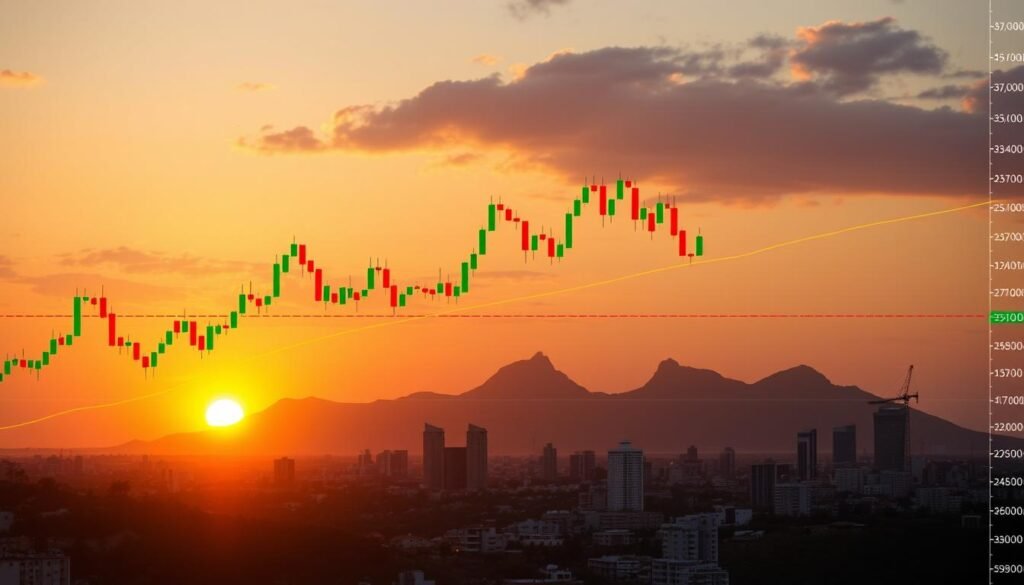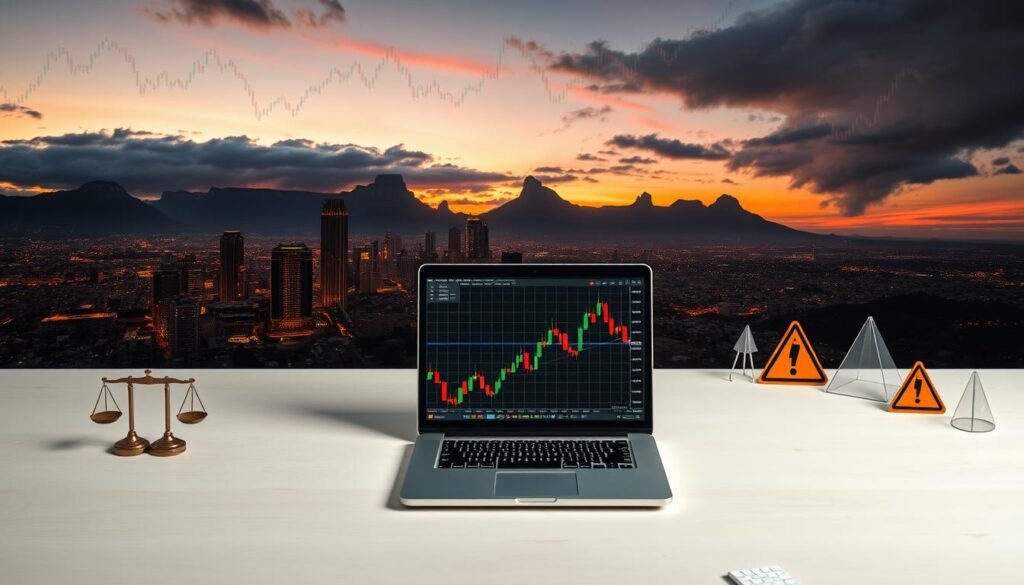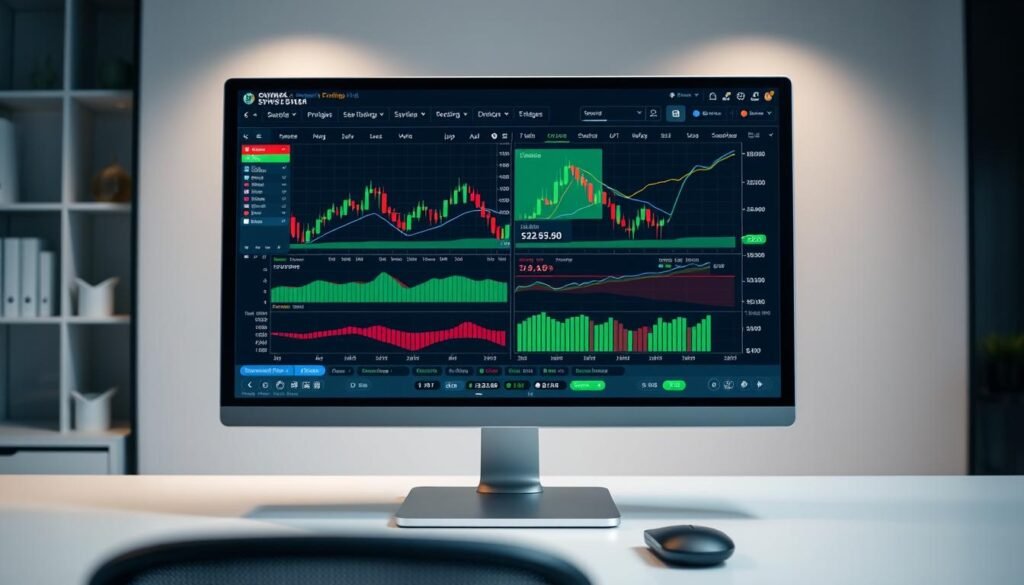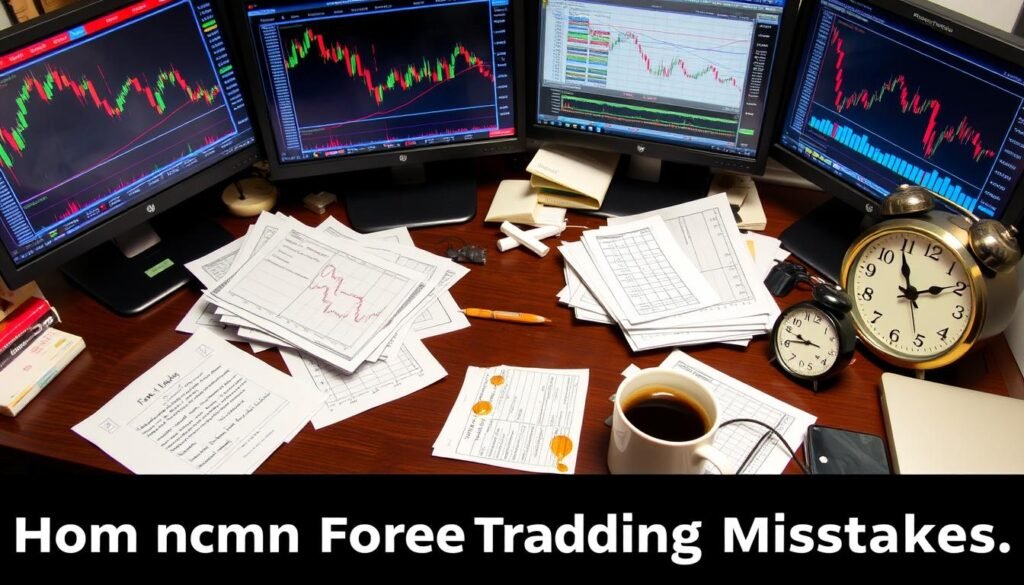Forex Trading in South Africa: Beginner’s Guide
Welcome to the world of forex trading in South Africa! This guide will help you start your journey in currency trading. South Africa’s forex market offers exciting opportunities for new traders. We’ll cover everything from basic concepts to choosing online forex brokers in South Africa.
Forex trading lets you buy and sell currencies from around the globe. It’s a fast-paced market where fortunes can change in minutes. South African traders can join this global marketplace right from their homes or offices.
Whether you’re looking to diversify your investment portfolio or explore new financial horizons, forex trading in South Africa might be your next big move. Let’s dive into the essentials you need to know to get started on your forex journey.
Key Takeaways
- Forex trading involves buying and selling global currencies
- South Africa has a growing forex market with many opportunities
- Online forex brokers in South Africa offer easy access to trading
- Understanding market basics is crucial for new traders
- Proper research and education are key to successful forex trading
- Risk management is essential in currency trading
Introduction to Forex Trading in South Africa
Forex trading is becoming more popular in South Africa, offering great chances for investors. The market has grown fast, attracting both experienced traders and new ones. South Africa’s strong economy and financial sector make it a key place for forex in Africa.
South African traders can access global markets through many forex platforms. These platforms offer tools for analyzing currency pairs, making trades, and managing risks. The easy access to these platforms has made forex trading more appealing to local investors.
The South African rand (ZAR) is important in the forex market, often paired with big currencies like the US dollar, euro, and British pound. Knowing how these currencies relate is key for good trading strategies.
“Forex trading offers South Africans a chance to diversify their investment portfolios and potentially generate income from currency fluctuations.”
To do well in forex trading, South African investors need to understand the market, create good strategies, and keep up with economic news. Learning and practicing are crucial for dealing with the forex market’s complexities and making the most of potential gains.
Understanding the Forex Market
The foreign exchange market is key in currency trading south africa. It’s a global place where investors trade currencies from all over.
What is Forex?
Forex, short for foreign exchange, is the biggest financial market worldwide. It runs 24/7, five days a week, with huge amounts of money traded every day. In South Africa, more people are getting into forex trading to join global markets.
How does Forex trading work?
Forex trading means buying one currency and selling another. Traders make money when exchange rates change. For instance, if you think the South African Rand will get stronger against the US Dollar, you might buy ZAR/USD.
Major currency pairs in Forex
There are many currency pairs, but some are more popular. Here are the big ones:
| Currency Pair | Nickname | Countries |
|---|---|---|
| EUR/USD | Euro | Eurozone / United States |
| USD/JPY | Gopher | United States / Japan |
| GBP/USD | Cable | United Kingdom / United States |
| USD/CHF | Swissy | United States / Switzerland |
If you’re into forex trading education south africa, knowing these major pairs is crucial. They are very liquid and have tight spreads. This makes them great for both new and seasoned traders.
Legal Framework for Forex Trading in South Africa
Forex trading in South Africa is tightly regulated. The Financial Sector Conduct Authority (FSCA) watches over these activities. They make sure online forex brokers follow strict rules to protect traders from scams.
It’s important for traders to pick FSCA-regulated brokers. These brokers keep client money separate, offer clear prices, and ensure fair trading conditions.
“Regulation is the backbone of a secure trading environment. It safeguards traders’ interests and maintains market integrity.”
Brokers must also have a certain amount of money set aside. This rule helps ensure they can handle their costs and any losses they might face.
| Regulatory Requirement | Purpose |
|---|---|
| FSCA License | Ensures broker legitimacy |
| Segregated Accounts | Protects client funds |
| Minimum Capital | Guarantees broker stability |
| Transparent Pricing | Prevents hidden fees |
Traders should know that offshore brokers might not be under FSCA rules. Even if some are good, trading with them is riskier. Always choose regulated online forex brokers in South Africa for a safe trading experience.
Choosing a Reliable Online Forex Broker in South Africa
Finding the right forex broker is key for trading success in South Africa. With many options available, making a smart choice is vital.
Key factors to consider
When looking at forex trading platforms in South Africa, consider these:
- Regulatory compliance
- Trading costs and fees
- Available currency pairs
- Platform reliability and ease of use
- Customer support quality

Top-rated Forex brokers in South Africa
Some brokers are leaders in the South African forex market:
| Broker | Regulation | Min. Deposit | Spreads from |
|---|---|---|---|
| IG Markets | FSCA | R2,000 | 0.6 pips |
| XM | FSCA, CySEC | $5 | 0.6 pips |
| FXTM | FSCA, CySEC | $10 | 0.1 pips |
Regulatory compliance and safety
Make sure your broker is regulated by the Financial Sector Conduct Authority (FSCA). This protection ensures fair trading and safety for traders. Good brokers also have separate client accounts and protect against negative balances.
“Always prioritize safety and regulation when choosing a forex broker. It’s the foundation of a secure trading experience.”
Essential Forex Trading Platforms in South Africa
Forex trading in South Africa is becoming more popular. Many platforms are now available for traders. These platforms have features to improve trading experiences and results.
When picking a forex trading platform in South Africa, think about ease of use, device support, and tools. MetaTrader 4, MetaTrader 5, and cTrader are among the most popular.
MetaTrader 4 is a top choice for South African traders. It’s easy to use and has strong analytical tools. MetaTrader 5 has more features, like an economic calendar and more analysis options.
cTrader is known for its simple design and advanced charting. It’s great for traders who like a modern look.
| Platform | Key Features | Suitable For |
|---|---|---|
| MetaTrader 4 | Expert Advisors, Custom Indicators | Beginners and Experienced Traders |
| MetaTrader 5 | Multi-asset Trading, Advanced Charting | Advanced Traders |
| cTrader | Level II Pricing, Algorithmic Trading | Tech-savvy Traders |
Choosing the right platform is key for successful forex trading in South Africa. Try out different platforms with demo accounts. This will help you find the best fit for your trading style and needs.
Getting Started with Forex Trading: Step-by-Step Guide
Starting your journey in currency trading in South Africa can be exciting. This guide breaks down the process into simple steps to help you begin your forex trading adventure.

Opening a Trading Account
To start forex trading, you need an account with a reputable broker. Research different brokers, compare their offerings, and choose one that suits your needs. Look for brokers regulated by the Financial Sector Conduct Authority (FSCA) in South Africa.
Funding Your Account
Once your account is approved, it’s time to add funds. Most South African brokers offer various deposit methods, including bank transfers, credit cards, and e-wallets. Pick a method that’s convenient and secure for you.
Placing Your First Trade
With your account funded, you’re ready to make your first trade. Start small and focus on major currency pairs. Use a demo account to practice before risking real money. Remember, forex trading education in South Africa is crucial for success.
- Choose a currency pair to trade
- Decide whether to buy or sell
- Set your trade size and risk parameters
- Monitor your trade and close when ready
As you gain experience, continue learning about forex strategies and market analysis. This ongoing education will help you navigate the complex world of currency trading in South Africa.
Fundamental Analysis in Forex Trading
Fundamental analysis is key in forex trading in South Africa. It looks at economic indicators, news, and global events that affect currency values. This helps traders make smart choices in the market.
Economic indicators are vital. They include GDP growth, inflation, and job numbers. In South Africa, the Consumer Price Index (CPI) and Producer Price Index (PPI) are crucial for tracking inflation.
News events can greatly move markets. For instance, changes in interest rates by the South African Reserve Bank can change the rand’s value. Political news and global relations also matter.
Geopolitical factors go beyond South Africa. Global events, like trade deals or conflicts, can influence currency values everywhere. Traders must keep up with these global news to predict market changes.
“Understanding the broader economic context is essential for successful forex trading in South Africa.”
Forex trading education in South Africa stresses the need to mix fundamental and technical analysis. This approach helps traders make informed decisions in the fast-paced forex market.
| Economic Indicator | Impact on ZAR | Frequency |
|---|---|---|
| GDP Growth Rate | High | Quarterly |
| Inflation Rate (CPI) | High | Monthly |
| Interest Rate | Very High | Bi-monthly |
| Unemployment Rate | Medium | Quarterly |
Technical Analysis for South African Forex Traders
South African forex traders use technical analysis to make smart choices. This method looks at past prices and trends to guess future market moves. Let’s dive into the key parts of technical analysis in forex trading.
Popular Technical Indicators
Technical indicators show when to buy or sell. In South Africa, traders often use:
- Moving Averages (MA)
- Relative Strength Index (RSI)
- Bollinger Bands
- MACD (Moving Average Convergence Divergence)

Chart Patterns and Their Significance
Chart patterns give clues about price changes. Some common ones are:
| Pattern | Description | Significance |
|---|---|---|
| Head and Shoulders | Three peaks, with the middle peak higher | Potential trend reversal |
| Double Top/Bottom | Two peaks or troughs at similar levels | Possible trend change |
| Triangle | Converging trendlines | Breakout potential |
Using Technical Analysis Tools Effectively
To make the most of technical analysis tools, South African forex traders should:
- Use several indicators together for better results
- Practice on demo accounts before trading for real
- Keep up with the latest in forex trading education in South Africa
- Update strategies often based on market changes
By getting good at technical analysis, traders can make better choices. This can lead to better results in the fast-paced forex market.
Forex Trading Strategies for South African Traders
South African forex traders have many strategies to choose from. They can go for quick day trading or hold positions for a long time. The right choice depends on your goals, how much risk you can take, and how well you understand the market.
Day trading is a favorite among South African forex fans. It means opening and closing trades in one day. This method needs constant watching of the market and quick thinking.
Swing trading, however, keeps positions open for days or weeks. It’s less demanding but still needs regular market checks.
Long-term trading in South Africa looks at big economic changes. Traders hold positions for months or years. This requires patience and a good grasp of global economic trends.
Scalping is also becoming popular in South Africa. It involves making many trades in just minutes or seconds. Scalping can be profitable but needs fast reflexes and advanced tools.
“The key to successful forex trading in South Africa is finding a strategy that matches your personality and lifestyle. Don’t be afraid to experiment with different approaches.”
Success in forex trading in South Africa comes from consistent practice, learning, and careful risk management. Remember, no single strategy can promise success in the ever-changing forex market.
Risk Management in Forex Trading
Managing risks is key in forex trading. South African traders must know how to protect their investments. Let’s look at important risk management strategies for forex trading in South Africa.
Setting Stop-Loss Orders
Stop-loss orders are crucial for limiting losses. They close your position when the market hits a certain price. This keeps your capital safe if the market goes against your prediction.

Position Sizing Techniques
Proper position sizing is vital for managing risks in South Africa. It’s about figuring out how much to invest in each trade. A good rule is not to risk more than 1-2% of your account on one trade.
| Account Size | Max Risk per Trade (2%) | Example Position Size |
|---|---|---|
| R10,000 | R200 | 0.02 lots |
| R50,000 | R1,000 | 0.1 lots |
| R100,000 | R2,000 | 0.2 lots |
Managing Leverage Responsibly
Leverage can increase both profits and losses. South African traders should use it wisely. Start with lower leverage and increase it as you get more experience. Remember, more leverage means more risk.
Good risk management is crucial for success in forex trading. South African traders should focus on forex trading education. This will help them master these techniques and reduce potential losses.
Common Forex Trading Mistakes to Avoid
Forex trading in South Africa is exciting but risky. Knowing common mistakes helps you trade better. Let’s look at some errors to dodge on your trading path.
One big mistake is overtrading. New traders often make too many trades, facing more risks. It’s key to follow your plan and avoid quick decisions.
Another error is ignoring risk management. Learning to set stop-loss orders and manage trade sizes is vital. These skills protect your money from big losses.
- Ignoring market news and economic events
- Failing to keep a trading journal
- Overusing leverage without understanding its implications
- Chasing losses with larger trades
Emotional trading is a big trap. Fear and greed can lead to bad choices. A disciplined approach and sticking to your strategy are crucial for success.
Lastly, not keeping up with education is a mistake. The market changes, and learning new strategies is important. This helps you adapt to new conditions.
“The goal of a successful trader is to make the best trades. Money is secondary.” – Alexander Elder
By avoiding these mistakes and learning continuously, you can boost your success in forex trading.
Forex Trading Education and Resources in South Africa
South Africa has a lot to offer when it comes to forex trading education. You can find online courses and webinars made just for local traders. These resources cover everything from the basics to advanced strategies, helping you improve your skills.
Online Courses and Webinars
Many platforms offer forex trading education in South Africa. You’ll find courses for all levels, from beginners to experts. Webinars provide live learning sessions with industry experts. They let you learn at your own pace and fit your schedule.
Books and Podcasts
Forex trading books by South African authors give you local market insights. Podcasts are perfect for learning on the go. They feature interviews with successful traders and market analysis. These resources help deepen your understanding of forex trading concepts.
Local Forex Trading Communities
Joining local forex trading communities can really help your learning. These groups share tips, discuss market trends, and offer support. Some even organize meetups or workshops. Being part of these communities gives you valuable real-world insights and networking chances.
FAQ
What is Forex trading, and how does it work in South Africa?
Forex trading is about buying and selling different currencies. In South Africa, people trade through online brokers. They aim to make money from changes in exchange rates.
Is Forex trading legal and regulated in South Africa?
Yes, Forex trading is legal and regulated in South Africa. The Financial Sector Conduct Authority (FSCA) oversees it. It’s important to choose licensed brokers for safety and protection.
What factors should I consider when choosing an online Forex broker in South Africa?
Look at several things when picking a Forex broker. Check if they are regulated, offer good platforms, and have various account types. Also, consider their spreads, commissions, educational resources, support, and reputation. Brokers with FSCA licenses are best.
What are the popular Forex trading platforms used in South Africa?
Popular platforms in South Africa include MetaTrader 4 (MT4), MetaTrader 5 (MT5), cTrader, and others from top brokers. These platforms give access to market data, analysis tools, and order execution.
How can I learn about Forex trading strategies as a beginner in South Africa?
Beginners can learn through online courses, webinars, books, podcasts, and local communities. These resources teach about analysis, risk management, and trading psychology.
What are the risks associated with Forex trading in South Africa, and how can I manage them?
Forex trading has risks like market volatility and potential losses. To handle these, traders should use stop-loss orders, size positions wisely, and manage leverage carefully.
Are there any managed Forex accounts or services available for South African traders?
Yes, some brokers and firms in South Africa offer managed Forex accounts. These services are for traders who want professional management of their accounts.





